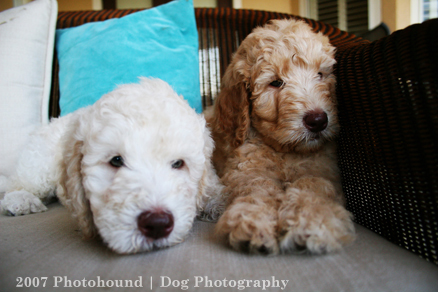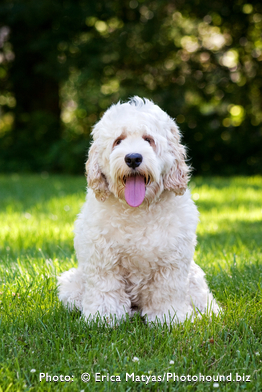Labradoodle and Australian Labradoodle Care, Health and Training Resources

Click below to find more information on our Labradoodle puppies.
Australian Labradoodle and Labradoodle Care
Problem Behaviors are best left to the experts. We recommend the following excellent resources:
- Raising Puppies and Kids Together Comes in your puppy package
- The Dog Whisperer on National Geographic
- Good Owners, Great Dogs, Click for book review and details
- Child Proofing your Dog, Click for book review and details
- How to Raise a Puppy You Can Live With, Click for book review and details Comes in your puppy package
- I Love My Dog, But...: : The Ultimate Guide To Managing Your Dog's Misbehavior
- How to Housebreak your puppy in 7 days Comes in your puppy package
Training We Recommend:
A Great Beginning:
We start to train and work with our puppies from the first day, socializing as well as following the suggested guidelines of the best trainers in the US. We have a well researched program of using sounds, small tasks, toys and other materials to influence and help your puppy be an easy going, fun loving, social and well trained adult. Trainers tell us that the most important time for your puppy is between 8 and 11 weeks so we work with you to understand what you can do to continue to prepare your puppy for the world.
Training:
We recommend training your puppy as much as possible. The best puppies know their boundaries and are taught what is expected with love and devotion. The sooner your puppy is trained the sooner it is given more freedom. Therefore, strict training results in big rewards for puppy and owner. Labradoodles are easily trained. They should be completely potty trained within 4 to 6 weeks after pick up. Most are sitting, staying, shaking paws, and retrieving by 3 months of age, many can get the newspaper and more by then with proper attention. Puppies will jump up and it takes time and consistency to break this habit early.
Crate training or room training is recommended:
First I will cover crate training then room training.
Crate Training:.JPG)
First get over the fact that to you it is a cage, to them it is a safe place when they are alone, safe from outside things and noises puppies have yet to become fearless of. They view it as their cave, a place they can sleep with the peace of mind. The crate should be just big enough for them to stand up, walk in a circle, and lay down. This is a different size at 8 weeks as it is at 4 months. Therefore I like something like the Life Stages Ultima Triple Door Folding Dog Crates from Petsmart where there is an additional wall that can be adjusted to increase the crate size as the puppy grows. It should contain toys. Bedding is typically used to pee on so do not use bedding until later once the dog can easily go all night without "going". I think the crate should be in a room, a selected safe room that later when the crate is no longer used becomes the place that when visitors come over who are not "dog people", the dog would stay in while these visitors are there. The first night the crate can be in a bedroom close to people and then later moved into the safe room if you desire. Some puppies pee in their crate at first and some don't, have patience. The point of the crate is to discourage peeing for a period of time. First crate the puppy for an hour or two and at night, then gradually longer. The point is to take the dog out before it has to go to the bathroom and as time goes by it can hold it longer and longer. Never more than 4 hours except at night when at first I recommend you get up twice during the night and let the puppy out, after two days wait and let the puppy out once in the middle of the night, gradually extend the wait time an hour until finally they have gone all night. After a few months I recommend graduating to room training. Remember to remove food and water an hour or more before leaving the dog in the crate, the puppy should be let outside and empty when left in the crate. At night take food/water away by 5pm so the puppy is really empty for the night. NEVER LEAVE A COLLAR ON IN A CRATE.Room Training:
Select a safe room that when visitors come over who are not "dog people", the dog would stay while the visitors are there. For example, an extra bathroom or utility room. It should contain a wee pad (if needed) and toys. Bedding is typically used to pee on so do not use bedding until later. Some puppies pee in their space at first and some don't, have patience. This is the reason for the wee pad, see "wee pad" for how this is used and gradually removed. The point of the room is to discourage peeing for a period of time and keep them out of trouble. First confine the puppy for an hour or two and at night, then gradually longer. The point is to take the dog out before it has to go to the bathroom and as time goes by it can hold it longer and longer. Never more than 4 hours except at night when at first I recommend you get up twice during the night and let the puppy out, after two days wait and let the puppy out once in the middle of the night, gradually extend the wait time an hour until finally they have gone all night. The room should be used up to a year when you are gone and at night. The sooner the puppy is trained and you can trust them the sooner they have free roam of the house. Remember to remove food and water an hour or more before leaving the dog, the puppy should be let outside and empty when left in the room. At night take food/water away by 5pm so the puppy is really empty for the night.Wee pads:
We put wee pads in the utility room when the puppies move into there, the wee pad is placed to one side. They have some chemical that draws the puppies...anyway if given the choice I am sure the puppies would "go" outside if they could go at anytime. Take them out as much as possible; the point of the wee pad is an emergency situation only. Eventually they only use the wee pads at night. I suggest the wee pad be placed close to bed, in their "room" or at the back door in case someone doesn't notice them at the door. It works like this, and please don't punish them for using the wee pad but don't congratulate them either, congratulate them when they go outside. Eventually they select to please you versus the wee pad and then they just stop using the wee pad. When it is dry for a few days take it away....done.
Food:
We recommend free food and water all day if you are home. Remember to remove food and water an hour or more before leaving the dog in the crate/room, the puppy should be let outside and empty when left in the crate/room. At night take food/water away by 5pm so the puppy is really empty for the night. We use the best puppy food available. We do not feed people food to our dogs ever, some things you would never imagine are actually toxic (listed below). When you pick up your puppy we give you a bag of food so you can continue it or mix it with whatever you desire slowly decreasing the amount of our food over time. But understand what you are feeding your dog.
To find a good food read the first 5 ingredients on the bag. http://www.thepetcenter.com/article.aspx?id=3395 the ingredients are listed in order of amount with the highest quantity listed first. Now ask the following questions:
What are the protein sources? We believe the primary source should come from quality animal protein, not vegetable protein or grain. Foods that list 2 or more grains in the first 5 ingredients may have more vegetable protein than animal protein. We prefer Chicken as the main ingredient.
What about grains? Two or more grains listed in the first 5 ingredients means your food may have more vegetable protein than animal protein. Grains such as soy, corn, corn gluten and wheat gluten can be difficult to digest, which means less nutrition, possible allergic reactions and more clean up. Wheat, barley, rice, corn and oats are all man-raised crops that a dog would never eat in the wild. These ingredients are not properly digested and in many situations cause a dog to show allergy symptoms.
Are there by-products? Some manufacturers consider by-products inferior sources of protein and, depending on the source, they can be difficult to digest. Most dog foods contain protein sources labeled as “meal”, “digest” or “by-product”. These ingredients contain meat sources that are typically unsuitable for human consumption.
What are the fat sources? Some fats are better than others. We believe the primary fat source in dog food should be animal based because animal fats contain a profile of fatty acids that are easily metabolized and thus are generally more available to the body.
- (Rainmaker's favorite food) Wellness CORE Grain Free from Old Mother Hubbard (available at PetSMART and Compete Pet Mart)
- Blue Buffalo Blue Wilderness (available at PetSMART )
- Canidae
- Chicken Soup for the Pet Lovers Soul (Complete Pet Mart and others)
- Lifes Abundance
- Natural Balance Ultra Premium (Complete Pet Mart and others)
- Orijen Orijen
Toxic items
First all dog owners should know where their emergency vet is located. The last thing you want is to be looking for the place when your dog is ill, late at night, so be prepared and do a dry run during the day. It may save a life.
Second you need to be aware how to make a dog throw up if he or she does ingest something they should not. This can be anything from a sock to the following foods. Please call your vet or emergency vet clinic for advice on if inducing vomiting is a good idea based on the item and time.
Vomiting will not help in some situations and could harm him or her even more, please...
- Do not induce if the dog has already started vomiting.
- Do not induce if the dog has lost consciousness, has trouble breathing, or she has become too weak to stand.
- Do not induce if the dog has swallowed bleach, drain cleaner or a petroleum distillate product. These products will burn the esophagus and mouth parts again on the way up.
- Do not induce if the dog swallowed the material more than two hours ago because the item or substance has likely passed into the small intestine, at which point your dog can't vomit it back up.
You can induce if…
- your vet has advised you to do it during your phone call;
- your dog has ingested antifreeze (ethylene glycol) no more than two hours ago
That said, follow these steps to induce vomiting.
- Into a small bowl, glass or mug, pour some three percent hydrogen peroxide, the same you have for a child's cut.
- Pour about 3 cc's for every 20 pounds of your dog's weight into a small cup.
- Open her mouth slightly tilting her head back, pour a steady stream of the hydrogen peroxide toward the back of her mouth, which will force her to swallow it.
- Wait ten minutes. If she hasn't yet started to vomit, repeat steps 2 and 3.
- Call your vet immediately if she doesn't vomit after the second dose.
So what is toxic to your dog besides the obvious, antifreeze? Well here is a list of those that will cause harm.
- Grapes, Raisins
- Candy, gum containing xylitol
- Mushrooms
- Castor Bean
- Cocoa powder, cooking chocolate, semi sweet chocolate, dark chocolate, milk chocolate in order of most toxic
- Onions and garlic
- Macadamia nuts
- Pear pits, the kernels of plums, peaches and apricots, apple core pits (contain cyanogenic glycosides in cyanide poisoning)
- Potato peelings and green looking potatoes
- Rhubarb leaves
- Moldy/ spoiled foods
- Alcohol
- Yeast dough
- Coffee grounds, beans and tea (caffeine)
- Hops (used in home brewing)
- Tomato leaves and stems (green parts)
- Broccoli
- Raw salmon
- Apple (stem and leaves)
- Yew (American, English, Western)
- Wild Cherry
- Japanese Plum
- Ficus(Cuban Laurel)
- Cherry
- Balsam Pear
- Ficus Lyrata (Fiddle-Leaf)
- Oak
- Philodendron (Devil's Ivy)
- English Ivy
- Jasmine
- Vine
- Matrimony Vine
- Virginia Creeper
- Asparagus Fern
- Caladium
- Colocasia (Elephant's Ear)
- Deiffenbachia (Dumb Cane)
- Philodendron (Saddle Leaf, Split Leaf)
- Poinsetta
- Mum (Pot and Spider)
- Umbrella Plant
- Aloe Vera
- Mistletoe
Vet Visits, Labradoodle Care:
Your new puppy will have been to our vet 5 times by the time you get him/her at 8 weeks, received deworming meds as well as 1st puppy shots. You will need to follow a series of follow-up puppy shots every 3 weeks for 3 more visits. You can start heartguard and flea or tick at 10 weeks of age. We use both and puppies receive heartguard via the nursing mom. Then the puppy goes to regular vet checks every 6 months. Labradoodles are typically very healthy and if breed correctly have little health problems.Home Care, Grooming and Health Care
- Grooming Process- A labradoodle can keep the long coat and be scissor cut about once or twice a year only. Leave the coat to grow to about 6 inches and cut back to 2 inches and start all over again.
- Brush
- Thin mats with thinning shears
- Trim shorter around lips, eyes and tush (under the tail) and around edge of feet and under feet
- Wash with shampoo and spray with a detangler
- DO NOT brush again, treat it like a human perm, either air dry or dry without brushing. This keeps hair corded not fuzzy.
- For short term mat care, thin area with thinning shears, brush just the area, spray with water and let air dry.
- Winter months if in snow we trim the feet edge and under more often to reduce ice from forming in paws and around paws.
- Summer months, labradoodles love to swim so keeping them clean is not as hard as keeping them dry. We cut our labradoodles shorter at the beginning of each summer...we live in Florida so it makes sense. A groomer can do this as above, just ask for a 2 inch cut all over, make sure they know it is a labradoodle and don't cut it like a poodle!
- Ears require pulling out the excess hair. You can do it yourself with tweezers, your fingers, or go to a groomer 3 times a year and they will do it with the regular bath and brush. If wax builds up ask the vet for an ear cleaner solution, you simply squirt it in and paper towel it off. Keeping ears clean and hair free is very important.
- Toe nails, the groomer and occasionally you can do it with a trimmer, I just trim the curl off to avoid bleeding. We do not amputate dew claws, they can be cut just like the other toe nails. You don't need your little finger either but you would not remove it.
- For the big stuff, here in Orlando we use Furry Clean 407-468-4944 .